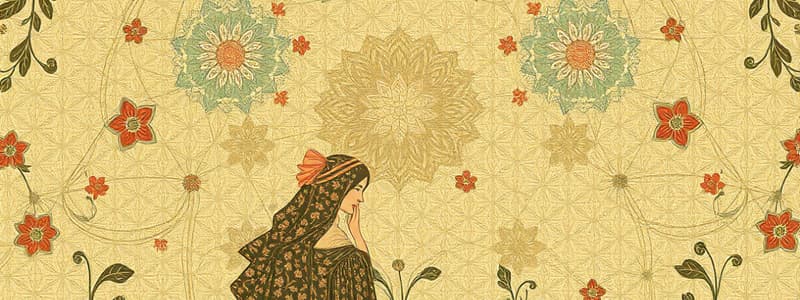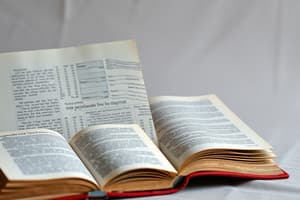Podcast
Questions and Answers
What best describes primary sources?
What best describes primary sources?
- Summaries of events with analysis.
- Gathered information from multiple secondary sources.
- Original, uninterpreted materials used for research. (correct)
- Materials created by someone with no firsthand experience.
Which of the following is NOT classified as a secondary source?
Which of the following is NOT classified as a secondary source?
- Biographies based on interviews.
- Books summarizing research findings.
- Academic journal articles reporting original data. (correct)
- Documentaries outlining historical events.
Which of the following options characterizes Indigenous Media?
Which of the following options characterizes Indigenous Media?
- Media that analyzes indigenous history from an outsider perspective.
- Varieties of media expressions by indigenous people globally. (correct)
- Media produced by non-indigenous people about indigenous cultures.
- Media created exclusively for indigenous audiences.
What is the primary function of a proverb?
What is the primary function of a proverb?
Which of the following best describes a tanaga?
Which of the following best describes a tanaga?
What defines a folk epic?
What defines a folk epic?
What is unique about the performance of panunuluyan?
What is unique about the performance of panunuluyan?
Which activity is associated with the Lenten period in the culture discussed?
Which activity is associated with the Lenten period in the culture discussed?
How do karagatan players typically participate in the performance?
How do karagatan players typically participate in the performance?
Which of the following best describes an awit?
Which of the following best describes an awit?
Flashcards
Primary Source
Primary Source
Original, uninterpreted material used to understand an event or topic.
Secondary Source
Secondary Source
Information analyzed and interpreted from primary sources.
Tertiary Source
Tertiary Source
Summary of topics, terminology, and references for further research.
Indigenous Media
Indigenous Media
Signup and view all the flashcards
Newspapers
Newspapers
Signup and view all the flashcards
Academic Journals
Academic Journals
Signup and view all the flashcards
Books
Books
Signup and view all the flashcards
Almanac
Almanac
Signup and view all the flashcards
Website
Website
Signup and view all the flashcards
Library Catalog
Library Catalog
Signup and view all the flashcards
Study Notes
Sources of Media and Information
- Primary sources are original, uninterpreted, or "first-hand" materials used by researchers.
- Secondary sources are created by someone without firsthand experience of the events or conditions being researched.
- Tertiary sources give an overview of a topic, including terminology and references for further reading.
Sources of Information
- Newspapers
- Magazines
- Academic journals
- Books
- Almanacs
- Websites
- Databases
- Library catalogs
- Encyclopedias
Media and Information Resources
- Indigenous Media encompasses various expressions conceptualized, produced, and circulated by indigenous peoples globally.
Examples of Indigenous Media
- Riddles are wit tests requiring the audience to identify the object described.
- Proverbs make statements about what they describe, providing lessons to cope with life's problems.
- Tanaga is a short poem full of metaphors, establishing an analogy between human experience and an environment aspect.
- Folk Epics are long narratives based on tradition, beliefs, customs, ideals, and social values.
Duplo
- Introduced during the pre-Spanish period, connected to morning rituals and harvest celebrations.
- Karagatan players are well-trained, while modern players are guests, tasked with extemporaneous verses.
Panunuluyan
- Performed on Christmas Eve before midnight mass.
- A town school of local parish generally organizes this elaborate event.
- Tibag is a significant indigenous media item from the Spanish era, related to excavating mounds for finding the cross.
Pasyon
- A popular Lenten activity intended to purify the soul.
Cenaculo
- A theatrical presentation of the Passion and death of Jesus Christ, staged as a Passión.
Awit
- The equivalent of a metrical romance.
- Commonly deals with love between a Moro warrior or Christian warrior and a Philippine princess.
- Carillo, similar to Chinese and Japanese forms, involves skillful manipulation of figures.
Moro-Moro and Comedia
- Theatrical presentations intended to convert natives to Christianity.
Library
- A building or room housing literary, musical, artistic, or reference materials for use, not sale.
4 Major Types of Libraries
- Academic Libraries serve colleges and universities.
- Public Libraries serve cities and towns of all types.
- School Libraries serve students from Kindergarten to Grade 12.
- Special Libraries are in specific environments like hospitals, corporations, museums, the military, private businesses, and the government.
Internet
- A global computer network offering information and communication facilities via interconnected networks using standardized communication protocols.
Evaluating Information Found on the Internet
- Authorship
- Publishing Body
- Accuracy and Verifiability
- Currency
Things to Consider in Evaluating Information
- Reliability
- Accuracy
- Value
- Authority
- Timeliness
Reliability of Information
- Information is reliable if it can be verified and evaluated based on the trustworthiness of the source.
Accuracy of Information
- Accuracy refers to the closeness of a report to actual data, which varies based on the information type.
- Forecasts should align with actual data; financial values must be correct.
Value of Information
- Information is valuable if it helps users in making or improving decisions.
Authority of the Source
- Examine the author or publisher of the information.
- Assess the credibility of the source.
Timeliness
- Information's reliability, accuracy, and value can change depending on the time it was produced or acquired.
- Some information remains relevant throughout history.
Skills in Determining Reliability and Accuracy
- Reliability: Check the author, publication date, citations, and the site's domain (.com, .edu, .mil, .gov, .org).
- Accuracy: Check facts and cross-reference with other sources to ensure consistency. Also, determine the purpose behind the information.
Studying That Suits You
Use AI to generate personalized quizzes and flashcards to suit your learning preferences.
Related Documents
Description
This quiz explores different types of media and information sources, including primary, secondary, and tertiary types. It delves into specific resources like newspapers, academic journals, and indigenous media. Test your knowledge on how these sources can be utilized for research and understanding in various contexts.




